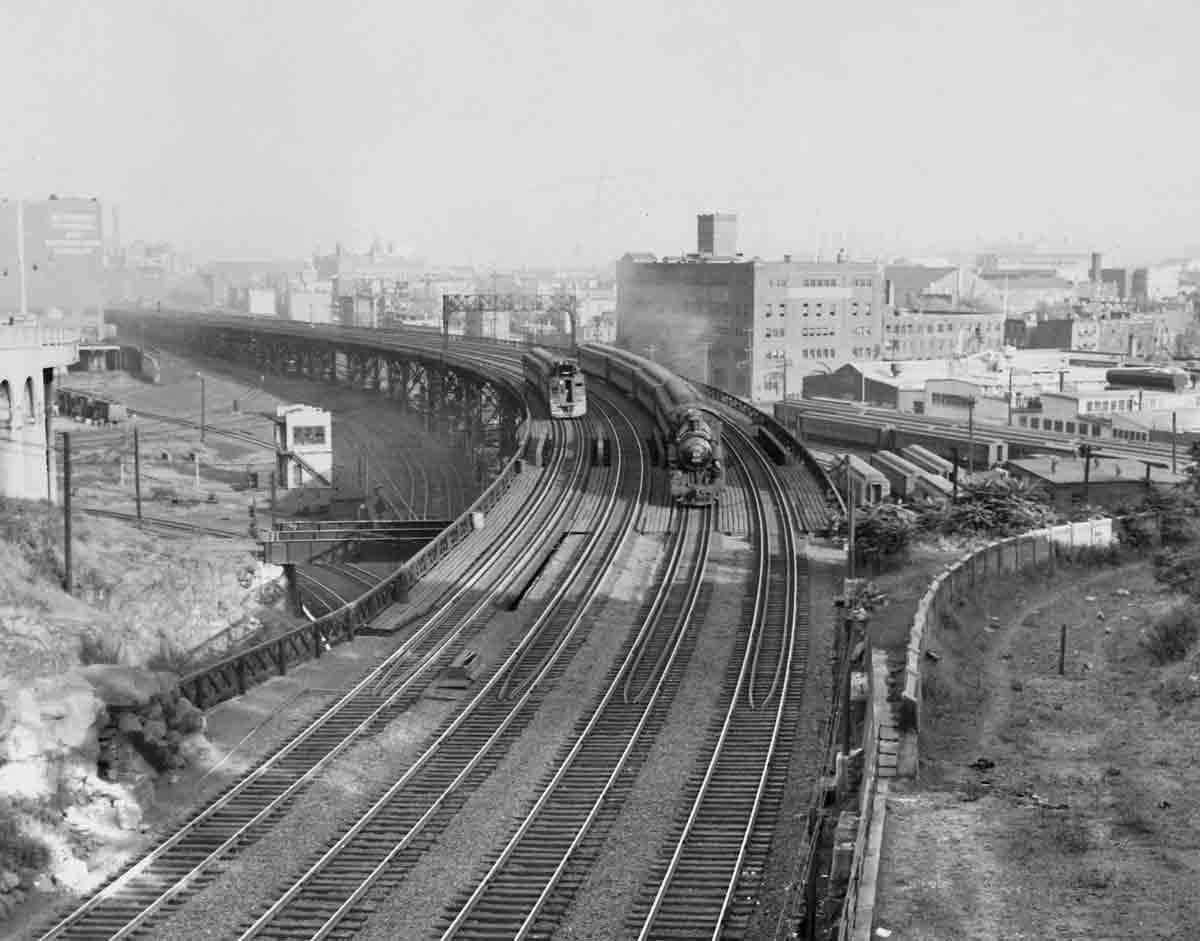Mother would pack a picnic lunch and off we would go. First was a bus ride from the Greenville section of Jersey City to Journal Square, where we would take the Hudson & Manhattan tubes to the Erie station stop at Pavonia Avenue. On the H&M, I would always ask that we ride in the first car so I could stand at the front window. As we left Journal Square station, we would be on ground level for about a mile, then the train would dive underground for the rest of the trip. In the tunnel it seemed like we were going 100 mph.
Once off the H&M, we would go up one flight of stairs to a tunnel that led to the Erie’s Jersey City terminal. After about a quarter of a mile, the tunnel opened up to the terminal’s concourse and waiting room, where there were trainboards and stairs up to each of the 12 platforms. We made our way to the Greenwood Lake train, which usually consisted of a gas-electric passenger-baggage “doodlebug” towing a Stillwell coach, or a steam engine (a K-class light Pacific or a G-class Ten-Wheeler) with a baggage car and a coach.
Leaving the station, to the left was a lineup of mainly Pacific locomotives on the ready track, and behind that was the roundhouse in which Dad worked. Then it was up the great steel viaduct to the “Bergen Arches,” a deep rock cut with several short tunnels through the Palisades, and out onto the meadowlands. After the train passed through the north end of Newark and the Montclairs, the countryside became more and more rural. By the time we got to Greenwood Lake, 43.5 miles and a couple of hours from Jersey City, it was all woods and mountains. The facilities there consisted of the station, an ice house, a boat dock, a hotel, and a turntable, all set at the foot of a mountain alongside the lake.
What a great experience for a young boy, sitting at the open window, absorbing the sights, sounds, and smells. Of course, thirsty or not, I had to make several trips to the end of the coach to have a drink of ice water. The paper cups came out of the dispenser as little white triangles that had to be unfolded to make cone-shaped cups.
At the time, ice was still cut out of the lake and stored in the ice house until it was shipped to the New York area. The dock was used by passengers crossing the lake to the west shore, where there was a colony of homes. They rode in a motor launch that held about eight people. The hotel was a two-story house with a large porch, part of which was screened in and populated by several canaries.
After we arrived, Dad would help the train crew turn the locomotive on the “Armstrong” (muscle-powered) turntable. The doodlebugs were too long for the turntable and had to back down the line to turn on a wye at, I believe, Ringwood Junction, 9 miles south.
In addition to eating, fishing, and swimming at the lake, we took time to go into the ice house. What a change from the brilliant sunlight of a hot day to the dark cool interior. It took a few minutes for your eyes to adjust to the dim light inside the building.
All this has changed during the last 70-plus years. The Hudson & Manhattan is now the Port Authority Trans-Hudson (PATH). The Erie Railroad terminal in Jersey City has vanished without a trace, replaced by a group of high-rise buildings and a huge shopping mall. The viaduct is gone, and the Bergen Arches are overgrown. Mechanical refrigeration has ended the use of ice houses. Railroad tracks no longer reach Greenwood Lake, which is encircled by a road. Other parts of the NY&GL are abandoned, submerged under a reservoir, or in use by New Jersey Transit’s Montclair-Boonton Line commuter trains.
It has all changed, but I still have my memories.
First published in Spring 2011 Classic Trains magazine.
Learn more about railroad history by signing up for the Classic Trains e-mail newsletter. It’s a free monthly e-mail devoted to the golden years of railroading.















I grew up in Jersey City, in Greenville(Gates Avenue, where I could go watch trains on the Jersey Central or the Pennsy trains going to the Greenville yard. When I took the “tubes” as my folks called the Hudson & Manhattan, which became Path as I entered high school, I often got to ride in the first car as it left Journal Square. It was also neat watching it as we came out of the tunnel back to Journal Square.
We have similar Jersey City memories – a bit apart in years but none the less similar. Grandma lived off Journal Square on Magnolia, right behind Loew’s Jersey (in Jersey City parlance: LOW-EES). Mom went came out of Sacred Heart parish and went to St Dominick’s. We kids were born in Margaret Hague and the family wakes were at Corrigan’s Funeral Home next to St Al’s; all the relatives are resting in Holy Name Cemetery and it is certain none has missed voting in an election since they were buried (this IS Hudson County!). Like you my brother and I used to race for the window in the first car on the Tubes and wait for the horn to blow as the train would enter or leave the tunnel. Although the Erie terminal is gone the columns in the Pavonia Avenue PATH station are still emblazoned with E on their capitals for ERIE.